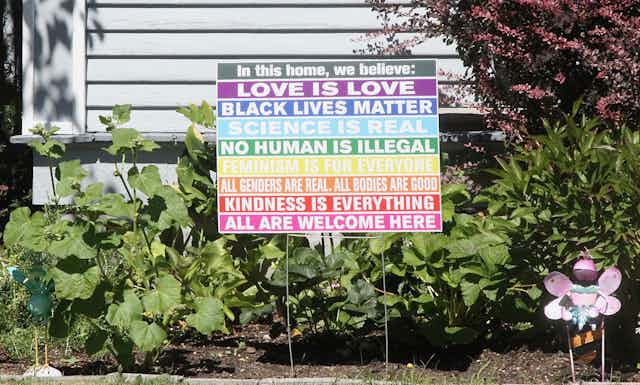The Impact Of Virtue Signaling On The Architecture Profession: A Candid Conversation

Table of Contents
The Manifestations of Virtue Signaling in Architecture
Public Statements and Social Media Posts
Architects, like many professionals, increasingly utilize social media platforms (Twitter, Instagram, LinkedIn) to express their views on social and political issues. This can range from tweets condemning unsustainable building practices to public endorsements of specific social justice causes. While such actions can raise awareness of important issues and foster dialogue, they also carry potential risks. For instance:
- Alienating clients: A strongly worded opinion on a politically divisive topic might alienate potential clients with opposing views, jeopardizing business opportunities.
- Damage to reputation: A poorly considered public statement can severely damage an architect's professional reputation, even if their intentions were good.
- Erosion of trust: Frequent and unsubstantiated claims of ethical action can lead to a perception of inauthenticity and erode public trust in the profession.
Design Choices as Statements
Architectural designs themselves can be interpreted as acts of virtue signaling. The choice of sustainable materials, the prioritization of accessibility features, and the incorporation of community engagement processes are all examples. However, it's crucial to differentiate between genuine commitment and performative actions.
- Greenwashing: The use of "green" materials as a marketing tactic without a true commitment to sustainability is a prime example of performative virtue signaling.
- Accessibility tokenism: Including minimal accessibility features as a checkbox rather than designing inclusively from the outset signals a lack of genuine commitment to accessibility.
- Community engagement as a facade: Superficial consultations with the community without meaningful incorporation of their feedback demonstrates a lack of genuine engagement.
Awards and Recognition
The architectural awards system might inadvertently incentivize virtue signaling. Judging criteria often include considerations of social impact and sustainability, potentially leading to a bias towards projects that emphasize these aspects, regardless of their overall design quality.
- Bias in judging panels: The composition of judging panels plays a critical role; a lack of diversity might lead to an unconscious bias towards certain types of projects.
- Public perception influencing awards: Awards can become popularity contests, rewarding projects that garner the most public attention rather than those with exceptional design merit.
- Incentivizing superficiality: The focus on awards can incentivize architects to prioritize demonstrable social impact over nuanced design solutions.
The Positive Impacts of Ethical Considerations in Architecture
Promoting Social Justice and Equity
When genuine, virtue signaling can translate into positive social impact. Architects have the power to promote inclusivity and address social injustices through their designs.
- Accessible design: Prioritizing accessibility features ensures that buildings serve all members of society, regardless of physical limitations.
- Affordable housing initiatives: Architects can contribute to solving the affordable housing crisis through innovative and cost-effective designs.
- Community-focused projects: Meaningful engagement with local communities leads to designs that better reflect their needs and aspirations.
Environmental Sustainability and Green Building
Ethical considerations in architecture play a crucial role in promoting sustainability. While some might label this virtue signaling, genuine environmental stewardship is critical.
- Sustainable materials: Choosing recycled and locally sourced materials minimizes environmental impact.
- Energy-efficient designs: Incorporating passive design strategies and renewable energy technologies reduces building’s carbon footprint.
- Lifecycle analysis: Considering a building's environmental impact throughout its entire lifecycle, from construction to demolition, is crucial for true sustainability.
The Negative Impacts of Virtue Signaling in Architecture
Diluting the Professional Focus
Overemphasis on virtue signaling can detract from an architect's core competencies.
- Compromising design quality: Prioritizing social messaging over functional design can result in poorly performing buildings.
- Neglecting technical expertise: Focusing on social media pronouncements may lead to neglecting the technical and practical aspects of design.
- Unrealistic expectations: The pressure to consistently signal virtue can be unsustainable and lead to burnout.
Alienating Clients and Stakeholders
Outspoken political or social stances can alienate potential clients, compromising professional relationships.
- Conflicts of interest: Public statements on politically charged topics may create conflicts of interest with certain clients.
- Damaged trust and collaboration: Differing viewpoints on social issues can undermine trust and hinder effective collaboration.
- Loss of projects: Clients may choose to work with architects whose views align more closely with their own.
Fostering Division and Polarization
Virtue signaling can exacerbate existing divisions within the profession and wider society.
- Social media echo chambers: Online platforms can amplify disagreements and create echo chambers where differing viewpoints are not tolerated.
- Reduced constructive dialogue: An emphasis on signaling virtue can hinder meaningful discussion about complex issues.
- Increased tribalism: Virtue signaling can foster a sense of "us vs. them," leading to decreased collaboration and understanding.
Conclusion
Virtue signaling in architecture presents a complex dilemma. While ethical considerations and social responsibility are crucial aspects of the profession, performative actions can undermine professional integrity and damage relationships. The key takeaway is the need for a balanced approach: integrating ethical considerations into design while maintaining professional focus and avoiding superficial displays of virtue. Let's continue the conversation about ethical practice and responsible virtue signaling in architecture to ensure a more just and sustainable built environment. Architects must strive for genuine commitment, transparent communication, and a deep understanding of the impact their work has on society and the planet, thereby transforming virtue signaling into meaningful action.

Featured Posts
-
 Severe Weather Awareness Week Day 5 Flood Safety Guide
May 26, 2025
Severe Weather Awareness Week Day 5 Flood Safety Guide
May 26, 2025 -
 Cyclist Mathieu Van Der Poel Spectator Fined For Spitting Incident At E3 Saxo Classic
May 26, 2025
Cyclist Mathieu Van Der Poel Spectator Fined For Spitting Incident At E3 Saxo Classic
May 26, 2025 -
 Le Frere D Albert Luthers Thierry Fait Face A Un Deuil Difficile
May 26, 2025
Le Frere D Albert Luthers Thierry Fait Face A Un Deuil Difficile
May 26, 2025 -
 Journalisme Hugo De Waha Jeune Talent Recompense Par La Bourse Payot
May 26, 2025
Journalisme Hugo De Waha Jeune Talent Recompense Par La Bourse Payot
May 26, 2025 -
 Michael Schumachers Benetton F1 Show Car Headed To Auction
May 26, 2025
Michael Schumachers Benetton F1 Show Car Headed To Auction
May 26, 2025
